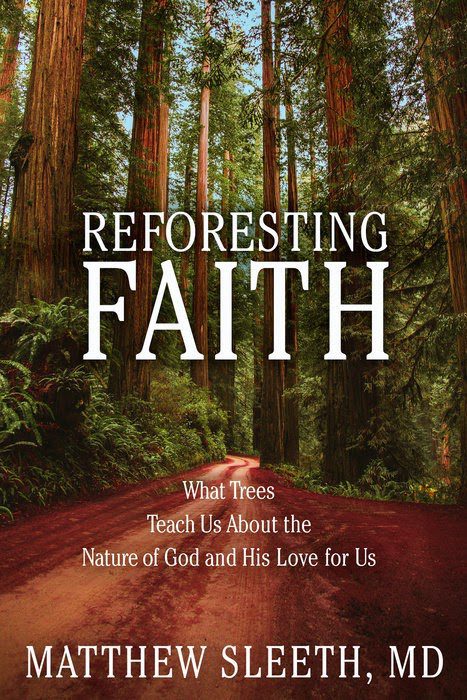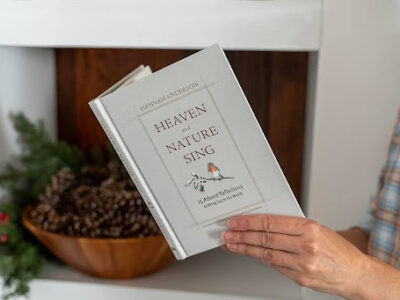
I open up Reforesting Faith to read, “Only God can make a tree,” an obvious enough statement for a Christian author to make. But as Matthew Sleeth begins to explore the intricacies of trees, the way they communicate and breathe, so similar to we humans, I realize he’s onto something special. I turn the page and my mind is blown.
“Christianity is the only religion that weaves trees from one end of its sacred text to the other. […] Other than God and people, the Bible mentions trees more than any other living thing. There is a tree on the first page of Genesis, in the first Psalm, on the first page of the New Testament, and on the last page of Revelation. Every significant theological event in the Bible is marked by a tree. Whether it is the Fall, the Flood, or the overthrow of Pharoah, every major event in the Bible has a tree, branch, fruit, seed, or some part of a tree marking the spot.”
“God chose a tree as his symbol of life. The largest and longest-lived form of life on the earth is a tree. Whether dead or alive, trees are always supporting life. It is not surprising then, that the author of life would put a tree at the beginning, middle and end of his message to us, the Bible.”
With literal years spent in Sunday school, Wednesday night Bible study, and all the extra-curriculars of a protestant upbringing, how did I miss this? Apparently I’m not the only one.
Sleeth explains, “In the 1611 King James Version of the Bible, the words tree, leaf, branch, root, fruit, and seed, occur 967 times. This tally doesn’t include specific tree names, such as palms, terebinths, figs, oaks, sycamores, acacias, willows, brooms, and tamarisks.” Fast forward to today’s translations of the Bible and we’ve somehow lost the trees. By Sleeth’s calculations the same six tree-related words appear “230 fewer times in the English Standard Version (ESV); 267 fewer times in the New International Version (NIV); and 274 fewer times the New Living Translation (NLT).”
I decided to ask some friends to join me for a walk in the woods, to find out just what all these trees mean to God, why they’ve gone missing from our Sunday sermons, and what we ought to do about it today.
From the Book Club
MAYLYN: Wow! This book! My biggest takeaway is the importance of recognizing God in nature, particularly in trees. Now I see trees as a living representation of scripture.
CINDY: There were so many Bible passages that took on a new meaning when looking with new eyes at teachings involving trees and their importance in the life of Jesus. It motivated me to study further the scripture contexts and other translations.
ERSKIN: In a world of self-help and easy believism, this book puts the proper emphasis on biblical theology and practice. Literally the entire world would be better by reading this. I was challenged by the attitudes of those who disregard trees and their present impact, because I have held many of those beliefs and am now more fully aware of my weaknesses in this area. We must all live in the light of God’s responsible truth in our day. If he comes today so be it, but until he comes we must plant our lives and trees to the glory of God.
KEVIN: We were put here to steward until the very last day, whether it’s our last day, or the farm that we’re on changes hands and now we are no longer a steward there. We still steward and remain faithful until the last day and a simple little sentence that Jesus said takes it all in — “Occupy until I come.” It’s that simple. Until he returns, it’s our responsibility to care for the earth. People think they’re not responsible to care for it because he’s going to remake it and create an earth untouched by sin. We’re still to occupy until he comes.
MAYLYN: We are a piece of creation too, and while we are fallen, I still think you and I are worth saving and worth taking care of — don’t you? Then I would go on to say that the Lord gave us the charge to have dominion over and to care for his creation.
CINDY I won’t look at a tree again without seeing the intricate design of God.
DEBRA: It’s so cool, how Matthew Sleeth writes, “At the level of respiration, humans and trees share an eerily similar architecture. […] A bronchogram beautifully demonstrates the trees we carry inside us; it’s indistinguishable from the shape of a bare oak tree.”
KATE: Could it be that God gave us Creation as a way to get to know him, and to survive and thrive in this life? His beloved trees sustain the very building blocks of life, the secrets of which confound scientists to this day. Is our DNA bound up in their roots, just as our lungs share the same beautiful architecture and breathe in the oxygen they transform for us?
KEVIN: The funny thing is, creation could get along without us, it would continue to reproduce and go on, but we can’t get along with most of creation. It’s such a paradox when you think about it. Here we are created in God’s image, sons and daughters of God going on to live forever — even the redwoods, the sequoias as old as they are, they won’t live forever, but we can. And yet, we’re the ones who without them can’t exist, but they can without us in their natural life cycles. It’s such a paradox.
MAYLYN: In “creation care” are humans caring for creation or is creation caring for humans? I would argue that, while both are taking place, creation is taking more care of humans by far! Creation is providing the literal air we breathe.
DEBRA: I feel that creation truly is caring for humans. Like the author says on page 29, “It is an inescapable fact of life; without humans, trees would manage just fine. Without trees, people would perish.”[…] “A people without children would face a hopeless future; a country without trees is almost as helpless.”
ERSKIN: God has a divine, supernatural and practical purpose for trees. For me, the constant press toward urbanization is checked by attention to trees. My pace, peace and patience are impacted for the good by knowing that God guided me to and through the trees.
CINDY: Every word, object and story in the Bible has value and meaning in our spiritual connection with God.
KATE: I love how Sleeth points out that God was doing more than putting on a cosmic show when he appeared to Job and his friends. He was revealing the science behind his artistry, facts and processes that we are only just now discovering in our modern research. He knows the code because he built this thing.
It seems like creation is the main medium through which God manifests his glory, power, strength, majesty… and his divine attention for us. As with the sparrow and the lily of the valley Jesus so lovingly references, we are being cared for and held every moment by the earth that sustains us and gives us life. It is all God’s creation, and we are just one part of it that he desired to be in direct relationship with, but he is in direct relationship with it all, as the Creator and sustainer of all life. To care for his great creative work is to care for him and for each other.
If you want to help reforest God’s creation, check out Plant with Purpose. For just $1 you can plant a tree that will provide oxygen for up to four people every day. And since 15 billion trees are cut down every year globally, we’ve got some work to do.
Join us in conversation with Reforesting Faith author Matthew Sleeth live on Reasons to Hope, Monday April 26 at 3pm ET.





 Copyright
2025
Root and Vine
Copyright
2025
Root and Vine